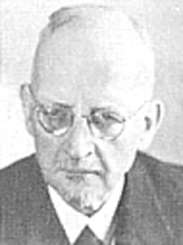Gerhard Kittel
Gerhard Kittel (23 September 1888, Breslau – 11 July 1948, Tübingen) was a German Lutheran theologian and lexicographer of biblical languages. He was an enthusiastic supporter of the Nazis.[1] and an open antisemite.[2][3] He is best known in the field of Biblical study for his Theologisches Wörterbuch zum Neuen Testament (Theological Dictionary of the New Testament).[4]

Biography
The son of Old Testament scholar Rudolf Kittel,[1] he married Hanna Untermeier in 1914, but there were no children from the union. In May 1933, he joined the Nazi Party.[4] He had had no previous involvement in politics but called the Party "a folkish renewal movement on a Christian, moral foundation".[4]
On May 3rd 1945, after Hitler's Third Reich capitulated to the Allies, Kittel was arrested by the French occupying forces, removed from office and interned at Balingen. In his own defense, Kittel maintained his work was "scientific in method" and motivated by Christianity, although it may have appeared antisemitic to some.[4] He attempted to distinguish his work from the "vulgar antisemitism of Nazi propaganda" like Der Stürmer and Alfred Rosenberg, who was known for his anti-Christian rhetoric, völkisch arguments and emphasis on Lebensraum.[4][5] Even so, Kittel admitted that he had attempted to "grapple with the problem of Jewry and the Jewish question."[4]
Professor Martin Dibelius, a theologian at Heidelberg, wrote that Kittel's works related to ancient Judaism "are of purely scientific character" and "do not serve the Party interpretation of Judaism." He said further that Kittel deserved "the thanks of all who are interested in the scientific study of Judaism."[4]
Claus Schedl, who attended Kittel's lectures on the Jewish Question in the winter of 1941–1942 in Vienna, said that "one heard not a single word of malice" and that "Professor Kittel truly did not collaborate." Schedl says that Kittel was one of very few scholars who promoted an opinion on the Jewish Question other than the official one. Kittel himself said his goal was to combat the myths and distortions of extremist members of the Nazi Party.[4]
Annemarie Tugendhat was a Christian Jew whose father had been taken to the concentration camp Welzheim in 1938. She testified that Kittel had strongly objected against the actions being taken against Jews. Kittel's work on the Jewish Question was not based on the racial theories of Nazism but upon theology.[4]
In 1946, Kittel was released pending his trial, but was forbidden to enter Tübingen until 1948. From 1946–48 he was a pastor (Seelsorger) in Beuron. In 1948, he was allowed back into Tübingen, but died that year before the criminal proceedings against him could be resumed.[4]
Nazi Germany
For the Third Reich, he produced antisemitic propaganda posing as scholarship.[1]
A Professor of Evangelical Theology and New Testament at the University of Tübingen, he published studies depicting the Jewish people as the historical enemy of Germany, Christianity, and European culture in general. In a lecture of June 1933 Die Judenfrage (The Jewish Question), that soon appeared in print, he spoke for the stripping of citizenship from German Jews, their removal from medicine, law, teaching, and journalism, and to forbid marriage or sexual relations with non-Jews—thus anticipating by two years the Nazi government, which introduced its Nuremberg Racial Laws and took away Jewish rights of German citizenship in 1935.[1] A close friend of Walter Frank, Kittel joined Frank's Reichsinstitut für Geschichte des neuen Deutschlands, a highly politicised organisation that claimed to be involved in scholarship, upon its foundation in 1935. Within this institute he was attached to the highly antisemitic Forschungsabteilung judenfrage.[4]
William F. Albright wrote that, "In view of the terrible viciousness of his attacks on Judaism and the Jews, which continues at least until 1943, Gerhard Kittel must bear the guilt of having contributed more, perhaps, than any other Christian theologian to the mass murder of Jews by Nazis."[6]
Literary works
- Die Oden Salomos überarbeitet oder einheitlich, 1914
- Jesus und die Rabbinen, 1914
- Die Probleme des palästinensischen Spätjudentums und das Urchristentum, 1926
- Urchristentum, Spätjudentum, Hellenismus, 1926
- Die Religionsgeschichte und das Urchristentum, 1932
- Founder and co-editor of the Theologisches Wörterbuch zum Neuen Testament, 5 vols., 1933–1979
- Ein theologischer Briefwechsel mit Karl Barth (A theological correspondence with Karl Barth, 1934 with Karl Barth
- Christus und Imperator, 1939
- Das Antike Weltjudentum – Forschungen zur Judenfrage (World Jewry of Antiquity – Research on the Jewish Question), 1943 with Eugen Fischer.[7]
References
- Robert P. Ericksen (2012). Complicity in the Holocaust: Churches and Universities in Nazi Germany. Cambridge University Press. pp. 8, 31–32. ISBN 110701591X.
- Ericksen, Robert, Theologians Under Hitler. New Haven, Yale University Press, 1985.
- Max Weinreich. Hitler Professors, New Haven, Yale University Press, 1999.
- Robert P. Ericksen, "Theologian in the Third Reich: The Case of Gerhard Kittel", Journal of Contemporary History, Volume 12, Number 3, July 1977, pp. 596, 599, 617–18
- "ALFRED ROSENBERG". The Holocaust Encyclopedia.
While Rosenberg's völkisch arguments and his emphasis on Lebensraum (German “living space” in the East) corresponded with Party ideology, many fellow Nazis found his mystical constructs and his prose hard going. Hitler himself held political reservations about Rosenberg's anti-Christian rhetoric. Until the end of his life, however, Rosenberg remained convinced his racist utopia would provide a recipe for Germany's future as the leading European power.
- Harold Willoughby (ed.), "The War in Europe and the Future of Biblical studies", The Study of the Bible Today and Tomorrow, Chicago, University of Chicago Press,1947.
- Das Antike Weltjudentum - Forschungen zur Judenfrage. 1943.
External links
- Christof Dahm (1992). "Kittel, Gerhard". In Bautz, Friedrich Wilhelm (ed.). Biographisch-Bibliographisches Kirchenlexikon (BBKL) (in German). 3. Herzberg: Bautz. cols. 1544–1546. ISBN 3-88309-035-2.
- Gerhard Kittel by Textus Receptus